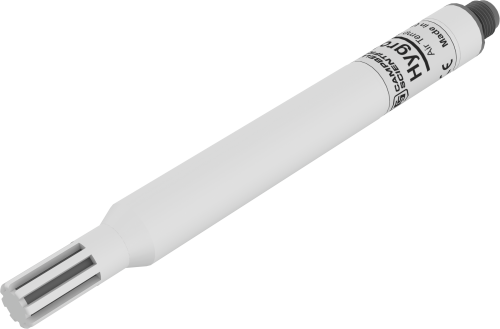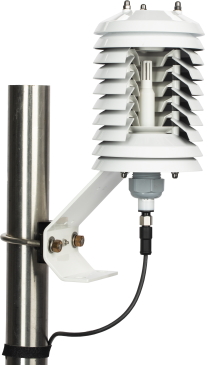Evolution Not Revolution: Updating an Established Product Range
by Andrew Sandford | Updated: 01/06/2020 | Comments: 0

Imagine that you already have a winning sensor that has sold more than 15,000 units. As time passes, you realize that technology has evolved, but your sensor hasn’t. If you are objective in your product evaluation, you may determine that there is justification for the expenditure of resources to design an improved replacement sensor—perhaps quite sooner than you may have anticipated.
In this blog article, Dr. Andrew Sandford, the Director of Research and Development at Campbell Scientific Limited in the UK, shares his recent experience in this design planning process for a temperature and relative humidity sensor range.
An Already Successful Product
The original CS215 Temperature and Relative Humidity Probe has been a great instrument and has proven to be very reliable. (Over its lifetime, more than 15,000 units have been sold.) The CS215 sensor element was based on the best tech available at the time (more than 10 years ago), and we had to consider how we might design a new sensor using more advanced technology.
We treated this project the same way as our other product development projects:
- We started from the outside in, looking at the market or customer problem we needed to solve.
- We reviewed how well our current solution solved that problem.
- If our current solution (in this case, the CS215) didn’t solve the problem, we looked to see what we could do to make it solve the problem.
Whilst the CS215 is still very accurate and reliable in comparison with similar sensors on the market, we felt there were improvements to be made and decided to design a new series of sensors. This process took about two years—from the initial idea for the new sensor through the design, testing, manufacture, and eventual release.
The Evolution of Design
Designing the new HygroVUE™ series of sensors involved retaining some capabilities of the CS215 while improving upon its other features.
The sensor element
The sensor element is at the heart of the sensor. When we were reviewing how we could improve the old sensor, this element was central to the project. Consequently, we reviewed and tested quite a number of alternate sensor elements to select the final one to use.
The combined temperature and humidity sensor element in the HygroVUE sensors is an updated CMOSens® element that offers a dramatic improvement in the accuracy of the temperature measurement. Accurate to a margin of error of 0.1 to 0.2°C, the sensor compares favourably to conventional standalone resistance thermometers.
In addition to the greater accuracy for both measurements, we have introduced two new filters to protect the sensor element by reducing dust ingress and the errors associated with contamination. Moreover, the entire sensor body is now potted to prevent any impact from moisture leaking into the sensor body.
One of the most popular features of the CS215 is the field-swappable sensor element. It was essential that the new HygroVUE sensors retained this capability. In fact, the field-swappable sensor element is such a key benefit, there was no way we were going to get rid of it! Fitting the replacement pre-calibrated element means no more measurement interruptions and no need to send the sensor back for calibration. It’s a win-win all round.
Use with radiation shields

The HygroVUE™5 is ideal for applications that use cost-effective, compact radiation shields such as the RAD06 6-Plate Solar Radiation Shield. The sensor body also fits within the space constraints of the TS100SS Aspirated Radiation Shield.
The HygroVUE™10 is ideal for meteorological applications where large radiation shields are used to ensure measurement accuracy. The sensor body fits many of the most popular and currently available shields including the RAD10E 10-Plate Solar Radiation Shield for Larger Sensors and the 41003-5 10-Plate Solar Radiation Shield.
Low power consumption and easier programming
Power consumption can be a big issue for customers who use battery or solar power solutions in remote measurement stations. Hence, reducing the power draw of the sensor was a key product development objective. The CS215 is a low-power sensor, but with the HygroVUE sensors, we’ve made the power consumption even better. It is less than half of the power draw of the CS215.
In-between measurements, the HygroVUE sensors draw less than 50 microamps. Even when making a measurement, they draw less than 1 milliamp. Many similar sensors draw between 2 to 5 milliamps all the time. This means that the HygroVUE sensors draw 100 times less power in many applications.
The biggest benefit of the low power draw is that it removes the need to switch the sensor off and on with other hardware between measurement intervals, making programming significantly more straightforward. In remote locations where power can be an issue and site access can be difficult, reducing the complexity of an installation and of ongoing maintenance activities is essential. The HygroVUE sensors are specifically designed to be trouble-free and give the user one less thing to worry about.
Enduring rigorous testing
At the Campbell Scientific campus in Logan, Utah, there is a test facility known colloquially to Campbell people as “The Sensor Torture Chamber.” As its name suggests, various products are put through rigorous test regimes to ensure they can stand up to life in the field in whatever climate is needed. The HygroVUE sensors were no exception. In addition to the standard battery of tests and lifetime simulations, the HygroVUE sensors were tested in real-world installations across Campbell Scientific facilities.
“The Sensor Torture Chamber” has seen the downfall of many new humidity sensors. We design our sensors to ensure they are capable of performing at the extremes of what they may face in the field. This way, we can be assured of their reliability and robustness should they encounter anything that is out of the “norm” rather than folding at the first sign of adverse conditions.

In Summary
Despite the success of our CS215 Temperature and Relative Humidity Probe, we determined the timing was right to offer our customers even better sensors. Capitalizing on the strengths of the CS215 while making design improvements, we were able to create the new HygroVUE™ Digital Temperature and Relative Humidity Sensors—products truly born from evolution. We believe the new design of these sensors will serve our customers well for years into the future—when we will evaluate them to ensure they continue to solve the customer problem.
If you have any questions regarding the HygroVUE sensors, please post them below.















 Dr. Andrew Sandford is the Director of Research and Development at Campbell Scientific Limited in the United Kingdom. Andrew has been with Campbell Scientific Ltd for more than 30 years and leads a team of R&D engineers that has been responsible for the design and delivery of a wide variety of Campbell Scientific products.
Dr. Andrew Sandford is the Director of Research and Development at Campbell Scientific Limited in the United Kingdom. Andrew has been with Campbell Scientific Ltd for more than 30 years and leads a team of R&D engineers that has been responsible for the design and delivery of a wide variety of Campbell Scientific products.
Comments
Please log in or register to comment.